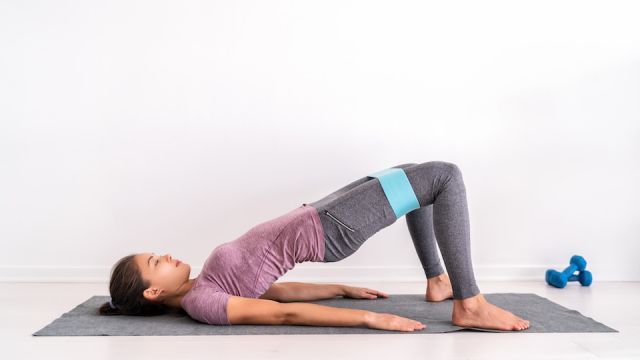
Abs, biceps, triceps, glutes, quads. You’ve likely heard of all of these muscle groups and probably spend time each week working some or all of them to help tone, strengthen, and define these key muscles. But there’s another muscle that you’ve probably been ignoring, and if you’ve even been pregnant, are getting older, or struggle with obesity (among other things), you’ll want to make sure you keep this muscle strong and prioritize working it. Otherwise, you may just end up peeing your pants the next time you sneeze or laugh. Ladies, here’s why pelvic floor exercises should be on your radar in 2020 and how to accomplish them for optimal results.
Why should you do pelvic floor exercises?
Keeping up on pelvic floor exercises strengthens the muscles around your pelvic region, including your bladder and vagina. They can help keep this area fortified during pregnancy and after childbirth and are beneficial for bladder control. Certain pelvic exercises may actually help make sex more enjoyable as well and act as a noninvasive treatment for pelvic organ prolapse.
Kegels
Kegels are by far one of the most effective and popular pelvic floor exercises, especially for increasing bladder control if you struggle with leakage due to things like laughing, jumping, or sneezing. Once you have identified which muscles you need to work, it is easy to do this exercise while you are sitting at your desk or just going about your day.
- The first step is actually to identify the muscles of your pelvic floor. The easiest way to do this is by stopping the flow of urination midstream. The muscles that are engaged when you do that are the muscles you will be focusing on.
- Note, do not continuously stop your urine flow as this could be harmful to your bladder. Simply use this method to locate the muscles and then do this exercise while sitting, not while peeing.
- Contract these muscles and hold it for five seconds. Be sure not to contract the muscles of your abdomen, buttocks, or glutes. You want to focus only on those muscles in your vagina.
- Then, release for five seconds.
- Repeat this 10 times, at least three times a day.
- Over time, this will build up your pelvic floor and help you regain control of your bladder.
Best times to do Kegels:
Sneaking in these important exercises is actually incredibly easy. Complete your sets while:
- Reading
- Working
- Driving
- Cooking
- Before bed
- Brushing your teeth
- Watching TV
Bridge
This exercise may seem simple at first; however, when done properly, you’ll really start to feel it in your glutes, abs, and pelvic muscles.
- Lie down on the floor with your knees bent at a 90-degree angle.
- Press your palms into the floor at your sides, making sure that your spine is flat against the ground.
- As you inhale, push up through your heels and raise your hips and back off the ground. While making this motion, be sure to squeeze your glutes, hamstrings, and engage your pelvic floor.
- Your body should be resting on your upper back and shoulders and forming a straight line from your bent knees.
- Pause slightly at the top, making sure to really feel your muscles contract, lower yourself, and repeat.
- Do 15 reps and 3 sets, resting for 30 seconds between sets.
Squats
Though squats aren’t necessarily one of the hallmark pelvic floor exercises, they still play a huge role in strengthening your lower body and keeping your glues and thighs tight and toned. Remember, when practicing squats, it isn’t about how low or how fast you can go but about your form when you are doing it.
- Do squats alone without any added weight first to make sure you are comfortable with the movement.
- Stand with your feet about shoulder-width apart and bend at the knees, push your butt back, keeping your back straight, chin tucked, and your weight in your heels.
- Remember, your knees should never go over your toes.
- Straighten your legs to return to an upright position and repeat.
- Add a barbell by resting it behind your neck on your trapezius muscles.
Other yoga and pilates exercises can help strengthen pelvic floor muscles, but it is always a good idea to isolate these muscles and target them specifically.
-The Alternative Daily

